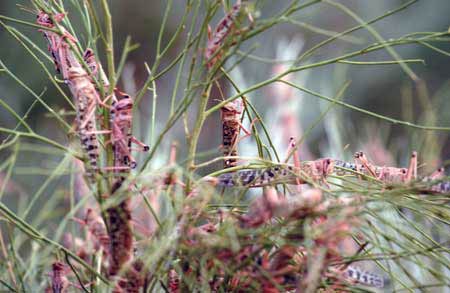UN food agency warns of danger to croplands in Mali and Niger from locust swarms
The United Nations warned today that croplands in Niger and Mali are at imminent risk from Desert Locust swarms that are moving southward from Algeria and Libya.

Desert locusts eating vegetation.
“How many locusts there are and how far they move will depend on two major factors – the effectiveness of current control efforts in Algeria and Libya and upcoming rainfall in the Sahel of West Africa,” a Senior Locust Forecasting Officer with the UN Food and Agriculture Organization (FAO), said Keith Cressman, said in a news release.
Groups of locusts have recently been found in northern Niger, arriving from infestations further north.
According to FAO, the Desert Locust swarms can be dense and highly mobile – varying from less than one square kilometre to several hundred square kilometres, with at least 40 million and sometimes as many as 80 million locust adults in each square kilometre of swarm, and able to travel about five to 130 kilometres or more in a day.
A Desert Locust adult can consume roughly its own weight in fresh food per day, equivalent to about two grams every day. A very small part of an average swarm – or about one tonne of locusts – eats the same amount of food in one day as about 10 elephants or 25 camels or 2,500 people.
FAO says locust-control efforts in the region are being hindered by continued insecurity along both sides of the Algerian-Libyan border. Political insecurity and conflict in Mali could also hamper monitoring and control efforts if the locusts reach that country.
Locust infestations were first reported in southwest Libya near Ghat in January 2012 and in south-east Algeria. In late March, FAO warned that swarms could arrive in Niger and Mali by June. Continued rains and the resulting growth of vegetation led to the formation of swarms by mid-May.
FAO notes that both Algeria and Libya have been working hard to treat infested areas, covering a total of 40,000 hectares in Algeria and 21,000 hectares in Libya as of the end of May.
"In a normal year, Algeria and Libya would have been able to control most of the local swarms and prevent their movement towards the south, but insecurity along both sides of the Algerian-Libyan border is getting in the way of full access by local teams and by FAO experts who need to assess the situation,” Mr. Cressman said. “Libya’s capacity to carry out control efforts has also been affected in the past year.”
Niger last faced Desert Locust swarms during the 2003-05 plague that affected farmers in two dozen countries.
The FAO Commission for Controlling the Desert Locust in the Western Region has provided $300,000 in funding to tackle locust infestations in Libya, and FAO has added an additional $400,000 to address the problem.
One of FAO’s mandates is to provide information on the general locust situation to all interested countries and to give timely warnings and forecasts to those countries in danger of invasion.
Source: UN NEWS
- 377 reads
Human Rights
Ringing FOWPAL’s Peace Bell for the World:Nobel Peace Prize Laureates’ Visions and Actions

Protecting the World’s Cultural Diversity for a Sustainable Future

The Peace Bell Resonates at the 27th Eurasian Economic Summit

Declaration of World Day of the Power of Hope Endorsed by People in 158 Nations

Puppet Show I International Friendship Day 2020

